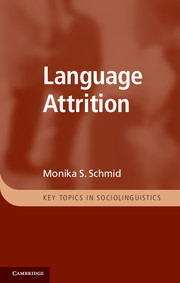Book contents
- Frontmatter
- Contents
- List of figures
- List of tables
- Preface
- Abbreviations
- 1 Introduction
- Part I Linguistic aspects of language attrition
- Part II Extralinguistic aspects of language attrition
- Part III Conducting research on language attrition – preliminary considerations
- Part IV Experimental designs for attrition research – the language attrition test battery
- Part V Coding and analysing the data
- 18 Conclusion
- Glossary
- Notes
- References
- Index
Part IV - Experimental designs for attrition research – the language attrition test battery
Published online by Cambridge University Press: 05 June 2012
- Frontmatter
- Contents
- List of figures
- List of tables
- Preface
- Abbreviations
- 1 Introduction
- Part I Linguistic aspects of language attrition
- Part II Extralinguistic aspects of language attrition
- Part III Conducting research on language attrition – preliminary considerations
- Part IV Experimental designs for attrition research – the language attrition test battery
- Part V Coding and analysing the data
- 18 Conclusion
- Glossary
- Notes
- References
- Index
Summary
When Barbara Köpke and I first became interested in the study of language attrition, we felt that one of the main problems of the field was the fact that there was no consistent methodology available for attrition studies. It seemed that everyone who had ever looked at attrition had invented their own approach, tests and questionnaires. This not only seemed like a huge waste of time but also contributed to the fact that little overall progress was made in the common understanding of how attrition takes place: no two findings could be compared to each other, and so nothing could ever be generalized beyond the scope of an individual investigation. We therefore decided to target our collective effort at providing a methodological framework that people would be able to adapt to different languages and different contexts.
The data collection instruments and experiments presented in this section are the outcome of these efforts. They were largely developed between 2003 and 2009 in the European Graduate Network on Language Attrition, a group of young researchers and Ph.D. and M.A. students working on language attrition in a variety of languages and settings. This group met on a regular basis and during those meetings we selected various tests and evaluated their potential for application in language attrition research. This means that for all of the tasks described here, previous findings from attrition in a range of first languages are available.
- Type
- Chapter
- Information
- Language Attrition , pp. 137 - 140Publisher: Cambridge University PressPrint publication year: 2011
- 1
- Cited by



